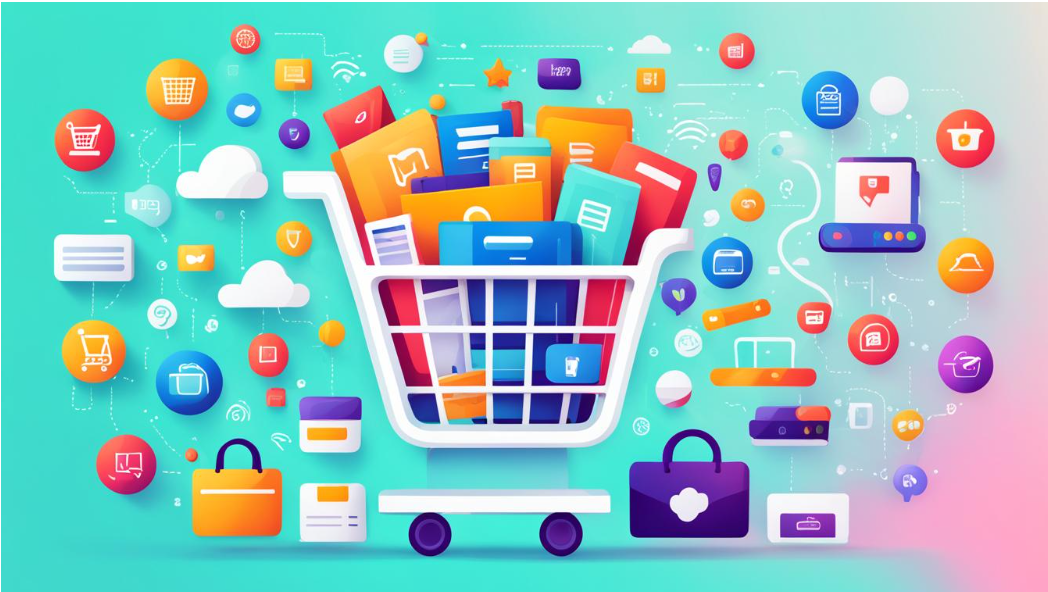The digital age has changed how we shop, bringing us online retailing or e-commerce. More people now shop online. It’s important for businesses to know about the different types of online shops and their benefits. This article will look at the world of online retailing. We’ll see the various models, their benefits, and what makes a digital shop successful.
Create an image of a virtual shopping cart, overflowing with products from various types of online retailers. The cart should be surrounded by icons representing the advantages and features of each type, such as fast shipping, easy returns, low prices, and personalized recommendations. Use bright colors and a modern, minimalist design to appeal to tech-savvy shoppers.
Table of Contents
Key Takeaways
- Discover the different types of online retailing, including B2C and B2B models.
- Explore the advantages of online retailing, such as global reach, enhanced customer experience, and cost-effectiveness.
- Understand the essential features of online retail platforms, including user-friendly interfaces, comprehensive product catalogs, and secure payment gateways.
- Gain insights into emerging trends, such as mobile commerce, click-and-collect retailing, and multi-channel strategies.
- Prepare for the future of online retailing and its transformative impact on the Indian retail landscape.
Introduction to Online Retailing
Definition and Overview
Online retailing is when people buy and sell things over the internet. It changed how we shop, making it easy and fun from home. Now, we can look at and buy lots of products without leaving our houses.
The Rise of E-commerce
The online retail world has grown a lot in recent years. More people are using the internet to shop. They like the easy access to many products and good prices.
A recent report said India’s e-commerce market will be worth $120 billion by 2025. This shows how big and growing this area is.
“The rise of online retail has changed how we shop. It gives us a smooth and easy way to shop.”
As people’s tastes and habits change, the digital marketplace will be more important. It will keep shaping the future of internet shopping and online retail.
Types of Online Retailing
In the world of e-commerce, two main models stand out: Business-to-Consumer (B2C) and Business-to-Business (B2B). It’s important to know about these models. They help businesses in the changing world of online retail models and e-commerce platforms.
Business-to-Consumer (B2C)
The B2C model is what most people think of when they talk about online shopping. Companies sell things directly to people through e-commerce platforms. These sites are easy to use, have lots of products, and make shopping easy for customers.
Some key things about the B2C model are:
- Intuitive and visually appealing website design
- Vast product selection and detailed product information
- Secure and convenient payment options
- Efficient order processing and delivery
- Personalized recommendations and customer support
Business-to-Business (B2B)
The B2B model is different. It’s when companies sell to other companies, not people. This model meets the needs of businesses like distributors, manufacturers, or service providers.
The B2B model has:
- Customized pricing and volume-based discounts
- Specialized product catalogs and procurement portals
- Streamlined ordering and invoicing processes
- Dedicated account management and technical support
- Seamless integration with the buyer’s existing systems
Knowing about these two online retail models is key for businesses in the fast-changing e-commerce world.
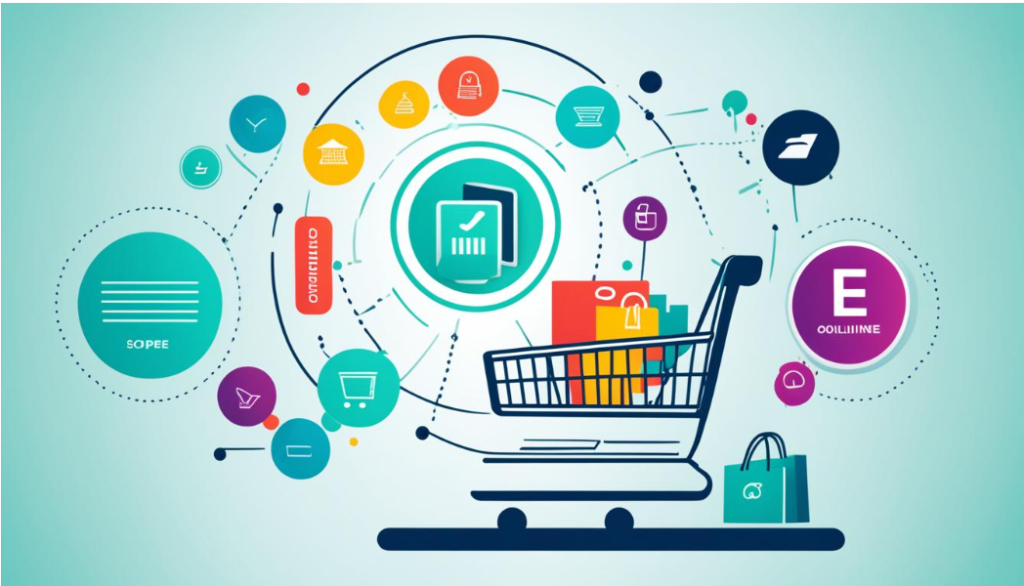
Create an image that represents the different types of online retailing, showcasing their unique advantages and features. Use abstract shapes and colors to visually depict the differences between the models. Incorporate symbols that are commonly associated with each type of online retailing, such as a shopping cart for e-commerce or a social media icon for social commerce. Use contrasting hues to highlight the benefits of each model, such as green for cost-effectiveness or red for convenience. Show how each model appeals to different types of customers, but also how they can complement each other to create a well-rounded online retail experience.
Advantages of Online Retailing
Online shopping has changed the way we shop. It has many benefits for both stores and shoppers. It has made shopping easier and more fun.
Online shopping lets stores reach more people. They can sell to customers all over the world. This has opened new markets for them.
Shopping online is very easy. You can look at products, compare prices, and buy from home. This is great when you can’t go out, like during the COVID-19 pandemic.
Online stores offer more choices and can make shopping personal. You can find many products and get things you like. This makes shopping fun and special for everyone.
Online shopping can also save money. Stores can have lower costs, which means lower prices for you. You can also look for the best deals easily.
These benefits have made online shopping very popular. It’s now a big part of how we shop today.
Show a happy customer sitting in front of a laptop with a shopping bag beside them, surrounded by icons representing various benefits of online shopping such as convenience, wide selection, easy returns, time-saving, and competitive prices. The laptop screen should display an online store with an appealing layout and attractive discounts to further emphasize the advantages of online retailing.

Features of Online Retailing
Online shopping is getting better all the time. E-commerce sites are adding new things to make shopping online better. They have easy-to-use sites, big product lists, and smart search tools. These changes are changing how we look for and buy things online.
User-Friendly Interfaces
Online shops focus on making things easy for users. They want shopping online to be smooth and easy. They use clean designs and clear menus to help shoppers find what they need quickly.
Product Catalog and Search
Big product lists are key in online shopping. You can find everything from clothes to gadgets. With smart search tools, finding what you want is easy. You can look for things by price, brand, or features.
| Online Retail Feature | Benefit for Customers |
|---|---|
| User-Friendly Interfaces | Streamlined navigation and intuitive browsing experience |
| Comprehensive Product Catalogs | Wide selection of products and easy exploration |
| Advanced Search Capabilities | Ability to quickly find desired items based on specific criteria |
These new features are changing how we shop online. They make shopping smooth and personal. As online shopping grows, these features will keep drawing in customers.
Create an image showcasing the convenience of online retailing, highlighting the ease of browsing and purchasing products from anywhere and at any time. Emphasize the wide selection of products available, including niche items and hard-to-find rarities. Use colours that evoke a feeling of excitement and satisfaction, and include imagery that reinforces the idea of shopping without limits, such as an open door or a globe.
“The future of retail lies in the seamless integration of technology and user experience.”
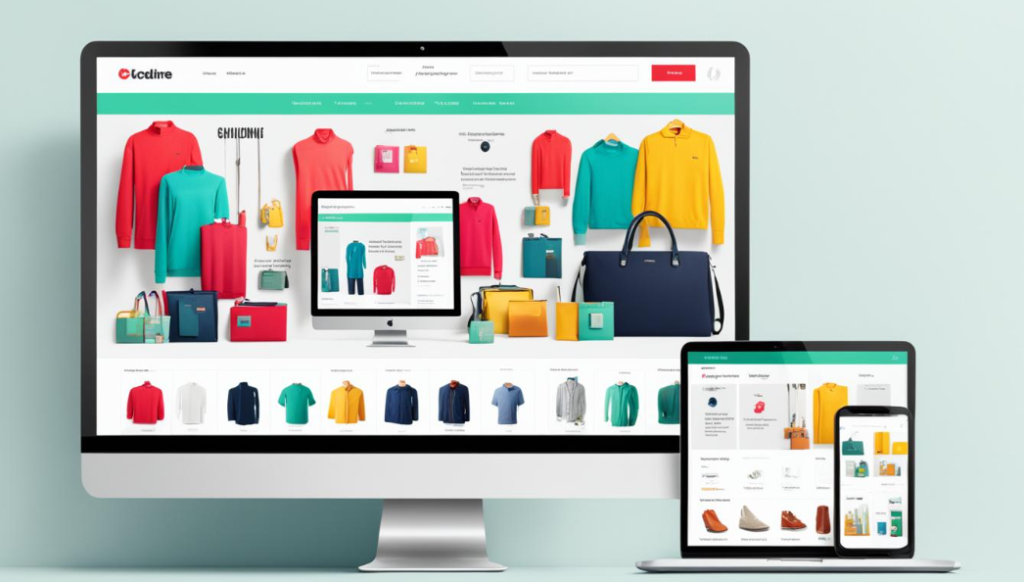
Online Retailing Types: Advantages and Features
Online retailing has many options for businesses and shoppers. Each option has its own benefits and features. From the B2C model to the B2B approach, online retail keeps changing to meet digital market needs.
Online retail lets businesses reach people all over the world. This can help them grow a lot. Shopping online is now easy and fun for people. They can look at and buy things from anywhere, even from home or while moving.
Features of online shopping are key too. Things like easy-to-use websites, lots of products to choose from, and good search tools help shoppers. These make shopping online better and help people find what they need.
Key Features of Online Retailing
- User-friendly interfaces that prioritize seamless navigation and accessibility
- Extensive product catalogs that cater to a wide range of consumer preferences
- Robust search functionalities that enable efficient product discovery
- Secure payment gateways that instill customer confidence in the transaction process
- Efficient order tracking and delivery systems that provide transparency and convenience
As online retail changes, businesses need to keep up with what customers want. They should use the best parts of online shopping to their advantage.
“The future of retail is not about physical stores or online shopping, it’s about creating a seamless, integrated experience for customers, wherever they are.”
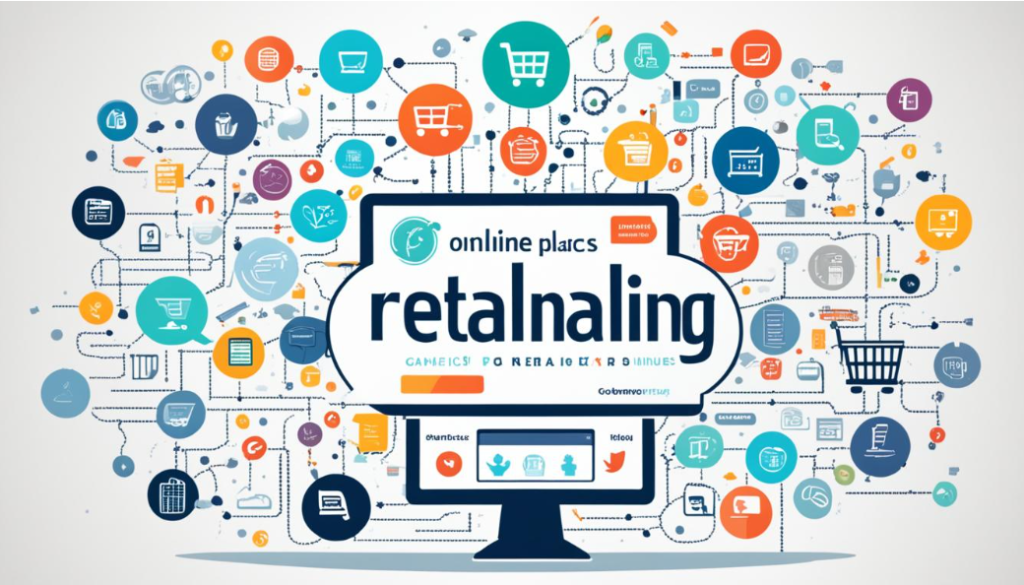
Create an image showing the various types of online retailing platforms, each with their own distinctive features and advantages. Depict the differences between marketplaces, e-commerce websites, and social media shops, highlighting the benefits of using each platform for different types of products. Use images and symbols to represent each type of platform, without relying on text or typography to communicate their names or functions.
Shopping Cart and Checkout Process
Online shopping carts and checkout processes are key to selling things online. They help make buying easy and build trust with customers. A good checkout process is key to making sales.
The shopping cart lets customers add items and check their choices before they go to checkout. Then, they give their payment and delivery info.
A smooth checkout builds trust and helps keep customers from leaving their carts. Customers want a quick and safe way to pay for things.

Create an image of an online shopping cart that represents the convenience and ease of the checkout process for customers. Use minimalist design elements to highlight the different types of online retailing advantages, such as streamlined checkout, fast shipping, and a variety of payment options. Show how the cart seamlessly integrates with different types of products, from electronics to clothing, to emphasize its versatility. Use bright colors or contrasting hues to make it stand out on digital platforms and capture the attention of potential buyers.
- Clear steps to help customers through the process
- Safe payment ways, like digital wallets and credit cards
- Clear prices, including taxes and shipping
- The chance to check and change order details before buying
- Working well with the website’s look and feel
By making the shopping cart and checkout better, online stores can sell more and keep customers coming back.
Payment Gateway Integration
In the world of online shopping, making payments easy and safe is key. E-commerce sites need to offer many ways to pay online. This makes customers happy and keeps them coming back.
Secure Payment Options
A good payment gateway lets customers pick from many safe ways to pay. This includes credit/debit cards, digital wallets, and bank transfers. By doing this, shops can make customers trust them more. This makes buying things online easier and worry-free.
For any online store to do well, it must have strong secure online payments. Using the latest in payment tech, like SSL encryption and tokenization, keeps customer info safe. This stops bad guys from getting into the system. It makes paying online better for everyone.
| Payment Option | Key Features | Advantages |
|---|---|---|
| Credit/Debit Cards | – Widespread acceptance – Instant transactions – Secure encryption | – Convenient for customers – Fast checkout process – Reduced payment friction |
| Digital Wallets | – One-click payments – Biometric authentication – Reduced risk of fraud | – Improved user experience – Enhanced security – Increased conversion rates |
| Direct Bank Transfers | – Direct debiting from bank accounts – Lower transaction fees – Suitable for high-value purchases | – Cost-effective for businesses – Preferred by some customers – Reduced risk of chargebacks |
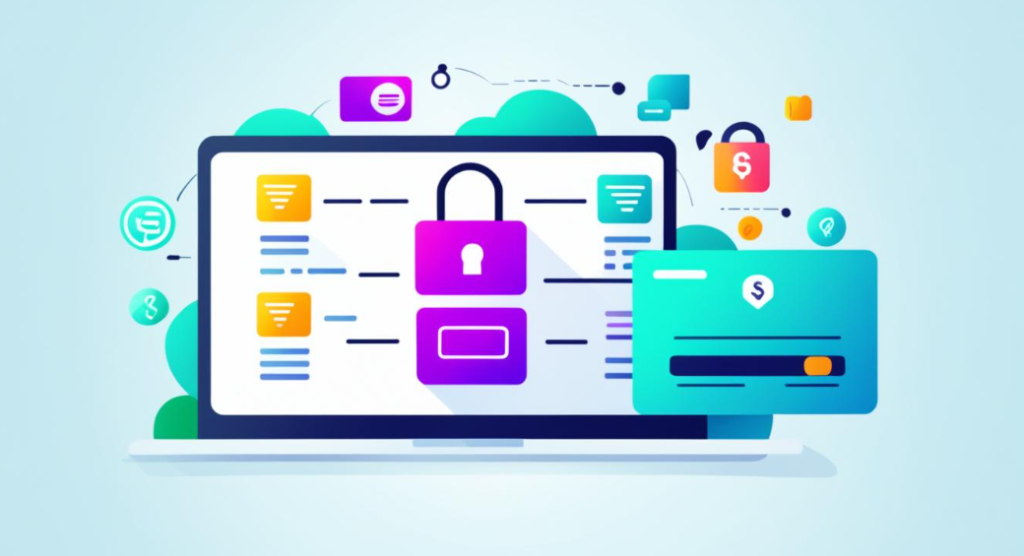
Create an image of a digital storefront displaying multiple online payment gateways. The storefront should be modern and sleek, with bright colors that symbolize convenience and security. Each payment gateway should be represented by an icon or logo, showcasing their unique features and advantages. Some icons could include a padlock to represent secure transactions, a shopping cart to symbolize ease of use, and a credit card to indicate accepted forms of payment. Make sure the image conveys a sense of variety and choice to the consumer.
By offering many secure online payments choices, online stores can meet what their customers want. This makes shopping better and can lead to more sales.
Order Tracking and Delivery
In the world of online retailing, tracking orders and delivering them fast is key. These steps make shopping better and build trust with customers.
Being able to track online orders in real-time changes the game. Good e-commerce delivery and shipping and fulfillment systems make shopping smooth. Customers can watch their orders from start to finish.
- Real-time order tracking gives customers peace of mind and a sense of control over their purchases.
- Accurate e-commerce delivery estimates and notifications help manage customer expectations and reduce frustration.
- Efficient shipping and fulfillment processes ensure timely deliveries, enhancing customer satisfaction and loyalty.
Putting a focus on online order tracking and delivery builds trust with customers. This leads to more customers coming back, good reviews, and a successful e-commerce business.
“Efficient order tracking and delivery are the cornerstones of a seamless online shopping experience.”
The need for online order tracking and delivery will keep growing. Online stores that focus on these will do better and connect more with their customers.
Mobile Commerce
Mobile commerce, or m-commerce, has changed how we shop online. Now, with smartphones everywhere, we can shop anytime, anywhere. Mobile commerce is key for online stores to reach more people and offer new ways to shop.
Responsive Design: The Key to Mobile-Friendly Experiences
Responsive web design is crucial for mobile shopping. It makes sure websites work well on all devices. This means shopping is easy and fun, no matter the device.
By making their sites and apps for mobile shopping, stores can attract more customers. They can also keep customers coming back. Features like easy searches and safe checkouts help grab the attention of shoppers on the move.
“The future of retail is mobile, and retailers who fail to embrace responsive design and mobile-first strategies risk losing relevance and market share.”
As more people shop on their phones, making online stores mobile-friendly is more important. Stores that focus on mobile will do well in the changing mobile commerce world.
| Feature | Benefit |
|---|---|
| Responsive Web Design | Seamless user experience across devices, increased customer engagement |
| Mobile-Friendly Navigation | Intuitive browsing and product discovery, higher conversion rates |
| Secure Mobile Checkout | Builds trust, reduces cart abandonment, enhances customer loyalty |
Click-and-Collect Retailing
The world of retail is changing fast. Click-and-collect is now a big deal. It lets you order online and pick up in person. This way, shopping is easy and quick.
With click-and-collect, you look at what you want online, pick it, and then get it at a store nearby. It’s great for those who like shopping online but also want to see their items right away. It makes shopping smooth and fun.
One big plus of click-and-collect is it’s fast. You don’t have to wait for your stuff to arrive. This is great for those who are in a rush or need things right away.
| Feature | Benefit |
|---|---|
| Convenient pickup locations | Customers can get their orders when it’s best for them, like on their way home or during shopping trips. |
| Reduced delivery costs | Retailers save on shipping, which means lower prices for customers or even free pickup. |
| Increased customer satisfaction | The click-and-collect way makes shopping smooth and happy, making customers come back more often. |
The click-and-collect model is a smart move for stores. It helps them keep up with what shoppers want and offers a new way to shop.
Dropshipping and Fulfillment
In the world of online shopping, two big changes are happening. They are dropshipping and e-commerce fulfillment. These changes make it easier and cheaper for stores and customers to handle orders.
Dropshipping means the store doesn’t keep products in stock. When a customer buys something, the store tells the maker to send it directly to the customer. This way, stores can sell many products without needing big storage spaces. It’s great for new businesses.
E-commerce fulfillment services take care of everything after you order something. They manage the stock, pack it, send it, and help with customer questions. This lets stores focus on what they do best and makes shopping smooth for customers.
Using these methods, stores can work better, save money, and offer more products. Order fulfillment services also make sure things arrive on time, which makes customers happy and loyal.
As online shopping grows, more stores will use dropshipping and fulfillment services. This will change the industry and make shopping easier and more valuable for everyone.
Multi-Channel Retailing
Today, businesses use many ways to reach their customers. Multi-channel retailing means using both online and offline ways to sell. This way, customers get a smooth shopping experience. By using an omnichannel strategy, stores can meet what customers want and expect.
Stores use many channels like websites, stores, apps, and social media. This lets customers choose how they want to shop. They can look at products, buy things, and track their orders easily.
Enhancing the Customer Journey
Good omnichannel strategies make shopping smooth and personal. They connect online and offline shopping. This gives customers a full shopping experience that fits their needs.
Customers can look at products, buy them, and get help across many channels. They always see the same brand and service.
- Consistent branding and messaging across all channels
- Real-time inventory visibility and product availability information
- Flexible order fulfillment options, such as in-store pickup or home delivery
- Personalized recommendations and targeted promotions based on customer data
More and more, shoppers want shopping to be easy and connected. Using multi-channel retailing and omnichannel strategies is key for businesses to stay ahead.
“Providing an omnichannel experience is no longer a nice-to-have, but a must-have for retailers who want to stay relevant and competitive in today’s market.”
The Future of Online Retailing
The world of e-commerce is always changing. We can expect exciting new things in the future. New tech, changing what people want, and the need for easy online experiences will change e-commerce a lot.
Artificial intelligence (AI) and machine learning are big in the future of online shopping. They will change how we shop, make things easier, and make customers happy. With AI, stores can give you what you like, work better, and be more efficient.
More people are shopping on their phones now. Stores need to make shopping easy on mobile devices. They should make websites and apps easy to use and add ways to pay with your phone.
| Emerging Trends | Key Features |
|---|---|
| Artificial Intelligence (AI) and Machine Learning | Personalized product recommendations, predictive analytics, automated customer service |
| Mobile Commerce | Mobile-optimized platforms, mobile applications, integrated mobile payment solutions |
| Augmented Reality (AR) and Virtual Reality (VR) | Virtual product try-ons, immersive shopping experiences, enhanced visualizations |
| Voice-Powered Commerce | Voice-based product searches, virtual personal assistants, hands-free shopping |
Soon, we’ll see more augmented reality (AR) and virtual reality (VR) in shopping. These will let you try on clothes and see products in new ways. It will make shopping more fun and help you decide what to buy.
More people are using voice to shop online too. With smart speakers and virtual helpers, you can find and buy things with just your voice. It’s making shopping easier.
As online shopping changes, stores need to stay quick and focused on what customers want. By using new tech and understanding what shoppers like, stores can do well in the changing online shopping world.
“The future of e-commerce is not about the technology itself, but about how it can be leveraged to create seamless, personalized, and engaging shopping experiences for consumers.”
Conclusion
This article has given a full look at the many types of online shopping. It talked about their benefits and what makes them special. Now, businesses and shoppers in India know how to pick the best e-commerce options.
It covered how e-commerce started and the different ways to shop online, like B2C and B2B. It showed how online shopping is easy, has lots of products, and makes buying simple. It also talked about how safe payments and tracking orders work.
The article also looked at new trends in online shopping. It mentioned mobile shopping, picking up orders, drop shipping, and selling through many channels. With this knowledge, both businesses and shoppers can use the big chances that online shopping offers.
also read :Luxury Laptop Under Rs. 40,000: Laptops with luxury features are available for just ₹ 40000
The advanced features of Mahindra Xuv 700 before and after
Luxury Range Rover Evoque launched in India with major updates, know what will be the price
Phone 15 for just ₹16,000! Know how to avail this amazing offer from Flipkart
FAQ
What is online retailing, and how has it risen in popularity?
Online retailing is when people buy and sell things over the internet. It’s gotten more popular because more people use the internet, have mobile devices, and like the ease it brings to shopping.
What are the two primary types of online retailing?
There are two main kinds of online retailing. One is Business-to-Consumer (B2C), where companies sell directly to people. The other is Business-to-Business (B2B), where companies sell to other companies.
What are the key advantages of online retailing?
Online retailing has many benefits. It reaches more people, is easy to use, offers lots of choices, personalizes shopping, and saves money for both stores and shoppers.
What are the essential features of online retail platforms?
Online shops need to be easy to use, have lots of products, let you search well, have safe ways to pay, and work with payment systems.
How does mobile commerce (m-commerce) impact online retailing?
Mobile commerce has changed how we shop online. More people use smartphones, and websites need to work well on phones to make shopping easy everywhere.
What is the click-and-collect retailing model, and how does it benefit consumers?
Click-and-collect lets you buy things online and pick them up in store. It mixes online shopping with the quick satisfaction of getting things right away.
How do dropshipping and fulfillment services impact online retailing?
Dropshipping and fulfillment help online stores manage their stock and shipping better. This lets stores focus on marketing and helping customers while someone else handles the delivery.
What is multi-channel retailing, and why is it important in the e-commerce landscape?
Multi-channel retailing combines online and offline sales to give customers a smooth shopping experience. It’s key in today’s market to keep up with customers’ changing habits.
What are some of the emerging trends and future developments in online retailing?
The future of online shopping will bring new tech like AI, AR, and voice shopping. These changes will shape how we shop and what we expect from stores.

